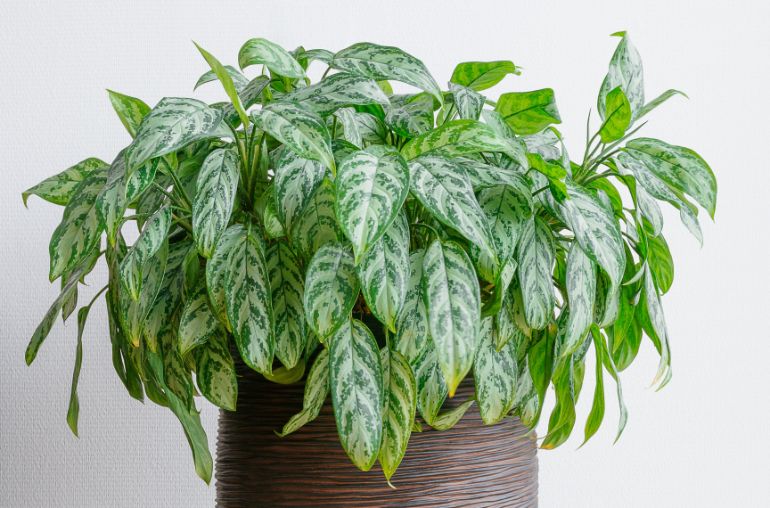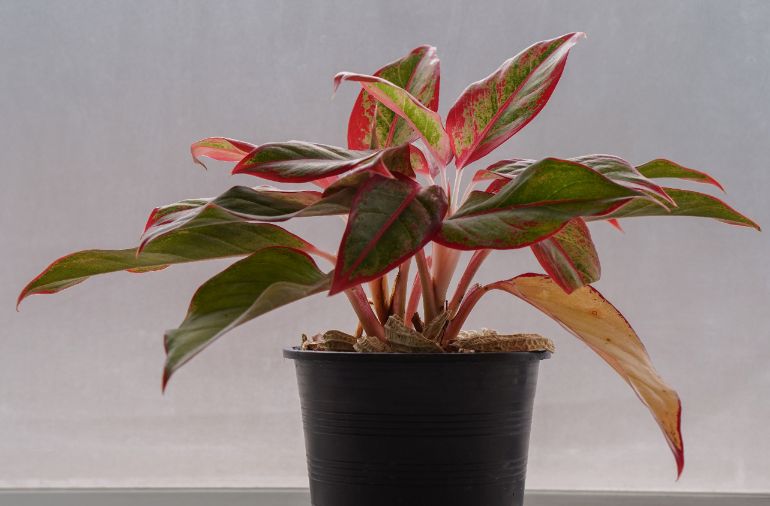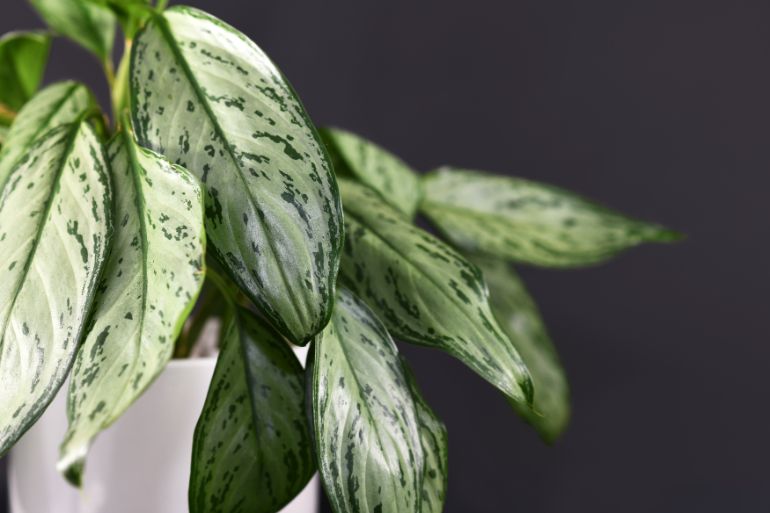The beautifully patterned foliage of the Chinese Evergreen, or Aglaonema, could easily belong to a demanding diva – but this popular houseplant is actually quite hardy and low-maintenance. Aglaonemas tolerate medium and even low light – but they aren’t invincible! In this article, we’ll explain common reasons you might see your Chinese Evergreen drooping and how to fix each issue.
A Chinese Evergreen with drooping leaves is often struggling with water issues: either too much or too little. Other causes include improper lighting, cold temperatures, drafts, and transplant shock. Also, check for pests, and make sure the plant isn’t becoming rootbound.
Overview: Why Your Chinese Evergreen’s Leaves Are Drooping
Chinese Evergreens (Aglaonema) comprise an Asian genus of flowering perennials. Traditionally grown for luck, many exciting hybrids are now grown worldwide for their broad and leathery foliage. Flowers aren’t the point with this plant – the spathes are often trimmed to direct the plant’s energy into producing more gorgeous leaves.
Besides their fancy appearance, Chinese Evergreens are wonderfully hardy beginner houseplants. They thrive in artificial light within climate-controlled conditions. Aglaonemas grow rather slowly and top out at about three feet high, so they won’t quickly outgrow their setting.
Drooping leaves means something isn’t meeting their general requirements. Here’s a quick care rundown:
- Aglaonemas adjust to low light but grow faster in bright conditions; however, intense illumination bleaches or scorches their foliage.
- Proper watering is important: dry soil can make your plant wilt, and overwatering promotes deadly root rot.
- The soil must drain well: a good recipe is one part potting soil to two parts perlite, orchid bark, or another aerating amendment.
- Average humidity is tolerated but higher levels are preferred.
- These are tropical plants that need year-round warmth.
- Chinese Evergreens must acclimatize to a new location or a repotting.
Fix drooping leaves by reviewing your Aglaonemas’s environment and care routine, and then correcting any deficiencies.
Note: It’s best to address each potential issue one at a time, so you can see when the plant improves and pinpoint the cause.
Drooping Can Sometimes Be Normal
What looks like drooping leaves can simply be the plant’s natural behavior. Chinese Evergreens present their broad foliage to the sun “face-first” … if their illumination comes laterally from a window – typical in a residential situation – they may simply be following the light.
Older leaves decline. They usually die from the bottom up. Each leaf turns yellow, dries out, and falls off; in the process, they often droop. You can’t stop your plant’s life cycle, so this cause of a Chinese Evergreen drooping isn’t a cause for alarm unless multiple leaves are affected simultaneously.
Some varieties have wavy foliage – if the plant is healthy and receiving good care, there’s generally nothing to worry about.
Causes Of A Chinese Evergreen Drooping
Let’s run through each of the issues that can result in your Chinese Evergreen drooping to help you find out what is wrong with your plant. The first two causes are the most common, while the rest are listed in no particular order.
1. Overwatering
It’s important to rule out overwatering first, so you don’t lose time or risk making the situation worse. Soggy soil is a life-or-death issue for your Chinese Evergreen.
The first signs are usually yellow leaves; eventually, the roots and stems die and become mushy. Unfortunately, if rot has progressed to the point the leaves are drooping, it’s probably too late. Steps can be taken, but even extreme measures may not salvage the plant.
Unpot the plant and check the roots: they should be firm, pale, and sweet-smelling and not mushy, dark, or giving off a foul odor.
To avoid the dire consequences, only water only once the top inch of soil has dried out. Common recommendations to “keep the soil moist at all times” don’t tell the whole story: the rootball should stay moist, but the topsoil needs to dry between waterings.
Sometimes you can accidentally overwater. Factors like temperature and light affect water consumption, and seasonal change can alter these gradually. Water less in winter when the plant isn’t active, and never water on a schedule: monitor the soil and only water when the plant is ready for it.
If you think you may have overwatered your Chinese Evergreen, read this article for some pointers to fix your plant.
Note: Empty excess water from the drip tray or cache pot after watering!

2. Underwatering
The other watering issue is letting the soil get too dry. The stems will droop and eventually, the foliage will turn crisp and die.
If the plant’s medium is bone dry, you’ll need to give it a thorough soaking. Dry soil can repel water, especially if it contains peat. Water several times, waiting a few minutes between each session. Excess water should drain through each time.
Alternatively, place the plant’s container in a reservoir of water for an extended period to allow it to soak up through the drainage holes.
After watering, check the soil using a chopstick or other wooden probe. Push it into the soil of the root ball, then pull it up and inspect its dampness to ensure the roots have been moistened.
Finally, commit to better watering habits to stop your Chinese Evergreen drooping – repeated droughts are bad for the plant’s health!
3. Cold Temperatures
Chinese Evergreens need warmth and are increasingly challenged as the temperature falls below 60ºF (15Cº). They won’t necessarily perish if it drops a few degrees lower, but the stress can contribute to drooping. Brief cold spells are problematic, too.
Sometimes your plant experiences conditions that are chillier than the ambient room temperature:
- Cold outdoor temperatures can make the floor much cooler than the room itself. The solution is to put the pot on supports to raise it a few inches.
- The air can be colder next to a window. A comfortable daytime windowsill can become an icebox overnight.
4. Drafts
Chinese Evergreens can droop if left in a draft or breeze. Drafts can also trigger browning on the leaves.
The remedy is simple: redirect the draft, provide protection, or move the container!
5. Acclimation
It’s easy to forget that moving a plant to a new location is a big deal to them. In nature, your Chinese Evergreen doesn’t have to deal with being transported wholesale to a new location.
Be patient and give your plant time to adjust to its new surroundings. They may droop a bit in the meanwhile, but don’t fuss with them. Don’t move them from place to place to get them to perk up. Put them in a favorable spot and let them adjust.
6. Transplant Shock
An important cause of a Chinese Evergreen drooping is shock from being repotted. The same reason that relocation is stressful to your plant goes triple for repotting. Changing the growing medium alters a plant down to, well, its roots.
You don’t need to frequently repot an Aglaonema: every two or three years in the spring is sufficient. They can be slightly rootbound without stress.
If you’ve recently repotted and the plant is looking droopy, be careful about making further changes. Make sure its conditions are favorable and be attentive to proper watering, and let it recover. Don’t fertilize until you see new growth.
7. Bright, Intense Light
This plant is legendary for its ability to cope with low light, but keep in mind that if truly deprived it won’t thrive. It may well droop on its way to plant heaven. Note that variegated plants can lose their color in low light.
However, the main light-related reason for drooping foliage is intense light. The stems can droop in bright, direct sun.
If your struggling Aglaonema is in high light, move it into bright, indirect light and see if it makes a difference. Pulling it a few feet from a sunny window may be all it needs.

8. Pests
A severe pest infestation might cause drooping leaves, but it isn’t the primary symptom of a pest infestation – curled, yellowing or mottled foliage are surer signs. Even so, pest pressures definitely add to the plant’s stress. If it happens, the lower leaves will typically be the first to droop.
The best answer is prevention. Check the plant routinely for evidence of unwelcome guests. Look closely under leaves and in stem joints. A magnifying glass helps identify tiny pests.
Chinese Evergreens aren’t overly susceptible to infestation, but mealybugs, in particular, can become a problem. They look like small bits of white fluff and hide in the plant’s crevices. If humidity is low, spider mites are another likely visitor.
If you see pests, don’t wait! An established infestation is more difficult to eradicate. Identify the pest and begin appropriate treatment immediately.
9. Disease
A few diseases that can infect a Chinese Evergreen, including Anthracnose and various forms of bacterial and fungal leaf spot, but these don’t tend to cause drooping.
However, there is one unlovely ailment called Curvularia which causes symptoms that look like drooping: it causes the petioles to stretch downward, giving the plant a wilted affect. Luckily, it’s uncommon. There’s no real cure anyway.
Keeping your plant healthy is the best protection for your plant!
10. Caged Roots
This is an odd item, but one to be aware of. Some especially popular plants like Chinese Evergreens are mass-produced and sometimes grown within small, plastic cages. If not removed, these cages can constrict and eventually stunt or kill the plant – this may trigger drooping as the plant struggles.
Unfortunately, this is surprisingly common, so check your plant’s root system and make sure it’s not caged. The device is easy to remove with a few snips.
11. Combination Of Stressors
The Chinese Evergreen is so hardy and adaptable that it can endure challenges like mediocre soil, low humidity, sporadic watering, inadequate light, under- or over-fertilization, etc. Your plant may not succumb to any one stressor, but together they can result in your Chinese Evergreen drooping.
If the care parameters seem adequate, a sovereign remedy is to increase its humidity. Consider providing more light, too, if the plant is in a dim environment; clean the leaves gently if they are dusty. TLC can bring back a languishing plant.
Last Word
If you find your Chinese Evergreen drooping, it’s important to look at the conditions your plant is growing in, as well as considering all the other symptoms your plant has, to help you determine the cause of the problem. Dealing with problems is part of the challenge of growing houseplants, and is a great way to learn.
If you’d like to learn more about growing beautiful houseplants, this website is full of helpful articles. You may like to read some of the articles listed below.

